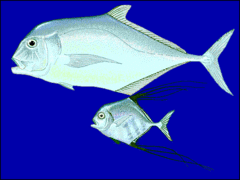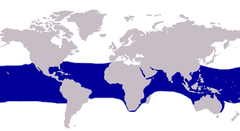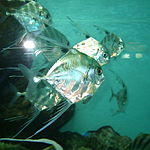- African pompano
-
African Pompano 
African Pompano (adult) and juvenile (bottom) Scientific classification Kingdom: Animalia Phylum: Chordata Class: Actinopterygii Order: Perciformes Suborder: Percoidei Superfamily: Percoidea Family: Carangidae Genus: Alectis Species: A. ciliaris Binomial name Alectis ciliaris
(Bloch, 1787)Approximate distribution of the African pompano throughout the tropical oceans. Note that only juveniles are pelagic, with adults inhabiting coastal areas. Synonyms The African pompano, Alectis ciliaris, (also known as the pennant-fish and threadfin trevally) is a widely distributed species of tropical marine fish in the Jack family, Carangidae. The species is found in tropical waters worldwide, with adults often inhabiting coastlines while juveniles are usually pelagic, floating with ocean currents. The adult African pompano is very similar in appearance to the other members of the genus Alectis, with close examination needed to separate the three. The juveniles, however, are easily identified due to their long, filamentous dorsal and anal fin tips which are thought to discourage predators. The species lives in depths less than 100 m, consuming a range of crustaceans and small fishes. The species is of minor economic importance, often taken amongst other tropical mid water fishes by hook and line while juveniles are occasionally caught in beach seines. African pompano are also highly rated game fish, often considered one of the strongest of the Jacks in larger sizes.
Contents
Taxonomy and naming
The African pompano is one of three members of the diamond trevally genus Alectis, which itself is one of 33 genera encapsulated in the jack family Carangidae. The Carangidae are perciform fishes in the suborder Percoidei.[1]
The species was first scientifically described by the German naturalist Marcus Elieser Bloch in 1787 under the name of Zeus ciliaris, described from the type specimen collected from Surat, India.[2] Following this description, a number of naturalists tried to reclassify the species as the taxonomic literature of fishes grew in volume.[3] Lacepède was the first to do so, giving it the name Gallus virescens, which although he intended to be a new genus, had been assigned to a group of birds previously. Rafinesque examined Gallus virescens in 1815, subsequently creating a new genus for the species; Alectis, and thus making Gallus virescens the type species, despite it being a junior synonym. A number of biologists also renamed the species completely, with Alectis crinitus and Carangoides ajax applied to the species.[4] All names except Alectis ciliaris are now considered defunct under the ICZN nomenclature rules. Interestingly enough, the original genus name of Zeus has now also been applied to an ascomycete fungi.[5]
The African pompano is not a true pompano of the genus Trachinotus, but is more closely allied with the fish commonly called jacks and trevallies. The various common names used for the species generally reflect the juvenile filamentous fins, with a number of variations on 'threadfin trevally' often used.[4]
Description
Like many of the Carangidae, the African pompano is a deep and laterally compressed fish, with the deepest point of the body located between the origin of the dorsal and anal fins and having the head and tail tapering either side. The dorsal and ventral profiles are equally convex, with a major distinguishing feature of the adult being its more curved head compared to Alectis indicus' more angular head profile.[3] The species has 4 to 7 visible spines in the first dorsal fin followed by a single spine and 18 to 20 soft rays in the second dorsal. The anal fin has two spines followed by 15 or 16 soft rays, while the pectoral fin is long and curved. The skin of the fish appears scaleless, but has minute, embedded scales scattered on the body.[4] The lateral line has a strong and moderately long arch dorsally, with its posterior section having 12 to 30 scutes.[3]
The juveniles are distinctive due to their 'threadfin' appearance of having trailing anal and dorsal fin filaments which recede with age. During maturation, the species also becomes more elongate and more like that of other genera of jacks.[3] The body is a silvery-metallic blue to blue-green colour above, being darkest on the head and upper shoulders while the underside is more silvery. The juveniles have 5 chevron-shaped dark bars on their body, with a black blotch at the base of the third to sixth soft dorsal fin rays. The base of the filaments is a dark blue to black, with all other fins pale to hyaline in appearance.[4]
The African pompano is known to definitely reach a length of 130 cm,[3] although larger specimens to 150 cm have been reported,[6] but are not considered reliable. The maximum published weight of the species is 22.9 kg.[7]
Distribution and habitat
The African pompano is distributed throughout the tropical oceans and seas of the world in a temperature range of 65 to 80 degrees Fahrenheit, although is more often found in coastal waters. The species has been recorded from both the east and west coasts of the USA, South America and Africa, throughout the Indian Ocean and along Asia and Australia, as well as many islands in the Pacific.[3] The African pompano does range into more temperate waters, with juveniles in particular captured off south eastern and western Australia, presumably carried by ocean currents.[8]
The adults of the species prefer coastal waters to depths of 100 m, inhabiting reefs and wrecks throughout the water column. Juveniles are pelagic by nature, inhabiting coastal areas as well as open ocean. Their reliance on water currents has seen them appear in estuarine waters in lower Australia, although due to cold winter temperatures, they do not survive the winters.[4] In one unusual case, the abundance in the species off North Carolina was found to dramatically increase after a hurricane had passed through.[9]
Biology
The African pompano is a schooling predatory fish which takes predominantly a variety of crustaceans including decapods, carids and copepods,[10] as well as cephalopods and small fish. They themselves are preyed upon by larger fish including mackerel and tunas as well as sharks.[7] The small pelagic juveniles' filamentous dorsal and anal fins resemble jellyfish medusae, and this mimicry may gain them some protection from predators.[3] Little is known of their reproductive habits and maturation lengths, although a study in India determined there was a peak in the abundance of A. ciliaris larvae in April. The eggs were also found to be spherical, pelagic with a yolk and oil globule present, with the larvae also extensively described in the report.[11] It is thought that in Mexico spawning occurs over sandy substrates in spring.[12]
Relationship to humans
The large size and good table fair offered by the African pompano have made the species popular with both recreational and commercial fishermen, although different sources rate the flesh quality differently. The species has been implicated in a number of ciguatera cases, suggesting larger fish should probably not be consumed.[13] The attractive appearance of juveniles make them possible aquarium fish, but they do not survive well in captivity.[7]
Commercial fishery
Adult African pompano are most often taken by hook and line methods, such as trolling[14] although don't often make up a high percentage of catches. Juveniles are occasionally taken by beach seines. The species is marketed both fresh as well as dried or salted.
Recreational fishery
The fighting prowess and good table fare attract anglers to the species in many parts of the world, with easily accessed areas such as Florida having a strong recreational fishery for the species,[15] as well as more remote areas such as Thailand and a number of Pacific and Indian Ocean islands.[14]
Tackle for larger fish must be robust, with 50 lb line on a large overhead or threadline type reel needed to prevent the fish from taking cover in underwater structure on its first run, especially on reefs and wrecks. Smaller fish are often taken on light tackle, often requiring a skilled angler to be able to land the fish in these situations. They can be caught on both bait and lures, with small live baitfish or large prawns the choice of baits rigged on strong gauge hooks. Lures are often jigs or streamers worked on deep reefs and wrecks, although they have been known to take a trolled lure or rigged bait.[16] In rare cases, they have even been known to hit saltwater flies on sinking lines and poppers at the surface.[15]
The recognized record for a recreationally caught African pompano is 18.8 kg.[8] In Florida, the species has a minimum size limit of 24 inches and only two fish are allowed per vessel per day.[17]
References
- ^ "Alectis ciliaris". Integrated Taxonomic Information System. http://www.itis.gov/servlet/SingleRpt/SingleRpt?search_topic=TSN&search_value=168602. Retrieved 21 October 2007.
- ^ Hosese, D.F.; Bray, D.J., Paxton, J.R. and Alen, G.R. (2007). Zoological Catalogue of Australia Vol. 35 (2) Fishes. Sydney: CSIRO. pp. 1150. ISBN 978-0-643-09334-8.
- ^ a b c d e f g Carpenter, Kent E.; Volker H. Niem (eds.) (2001). FAO species identification guide for fishery purposes. The living marine resources of the Western Central Pacific. Volume 5. Bony fishes part 3 (Menidae to Pomacentridae). Rome: FAO. pp. 2684. ISBN 92-5-104587-9. ftp://ftp.fao.org/docrep/fao/009/y4160e/y4160e00.pdf.
- ^ a b c d e Gunn, John S. (1990). "A revision of selected genera of the family Carangidae (Pisces) from Australian waters". Records of the Australian Museum Supplement 12: 1–78.
- ^ Minter, D.W.; Lowen, R. and Diamandis, S. (1987). "Zeus olympius gen. et sp. nov. and Nectria ganymede sp. nov. from Mount Olympus, Greece". Transactions of the British Mycological Society (London: Cambridge University Press) 88 (1): 55–61. doi:10.1016/S0007-1536(87)80185-7.
- ^ Sommer, C.; W. Schneider & J.-M. Poutiers (1996). FAO species identification field guide for fishery purposes. The living marine resources of Somalia. Rome: FAO. pp. 376. ISBN 9251037426. http://www.fao.org/docrep/010/v8730e/v8730e00.htm.
- ^ a b c Froese, Rainer, and Daniel Pauly, eds. (2007). "Alectis ciliaris" in FishBase. October 2007 version.
- ^ a b Hutchins, B.; Swainston, R. (1986). Sea Fishes of Southern Australia: Complete Field Guide for Anglers and Divers. Melbourne: Swainston Publishing. pp. 1–187. ISBN 1-86252-661-3.
- ^ Schwartz, Frank J. (2004). "Biological features of five poorly known carangid fishes frequenting inland and ocean waters of North Carolina". Journal of the North Carolina Academy of Science 120 (3): 99–105.
- ^ López-Peralta, R.H.; C.T. Arcila (2002). "Diet composition of fish species form the southern continental shelf of Colombia". Naga, WorldFish Center Quarterly 25 (3&4): 23–29.
- ^ Premalatha, P. (1991). "Studies on the carangid fish larvae of the southwest coast of India. Alectis ciliaris (Bloch, 1788) Alectis indicus (Ruppell, 1828) and Atropus atropus (Bloch, 1801)". Journal of the Marine Biological Association of India 33 (1–2): 1–8. Lay summary.
- ^ Mexfish.com. "African Pompano". http://www.mexfish.com/fish/afpomp/afpomp.htm. Retrieved 2007-10-21.
- ^ Bourdeau, P.; Bagnis, R. (1989). "Risk factors of ciguatera in the French West Indies in Saint-Barthelemy, Saint-Martin and Anguilla (Article in French)". Revue d'élevage et de médecine vétérinaire des pays tropicaux 42 (3): 393–410. ISSN 1951-6711.
- ^ a b Franke, Rebeca; Acero-P Arturo (1993). "Carangoid fishes of the Parque Gorgona, Colombian Pacific (Osteichthyes: Carangidae, Nematistiidae and Coryphaenidae)". Revista de Biologia Marina 28 (1): 51–73.
- ^ a b TCPalm Outdoors and fishing. "Sport Fishing". African Pompano. http://web.tcpalm.com/sports/areafish/apomp.htm. Retrieved 2007-10-21.
- ^ Champion Proguide Services. "Fish Encyclopedia". African pompano. http://www.championbass.com/encyclopedia/african_pompano.html. Retrieved 2007-10-21.
- ^ Florida Fish and Wildlife Conservation Commission. "Evolution of each regulation". Pompano, African Pompano, Permit. State of Florida. Archived from the original on December 4, 2004. http://web.archive.org/web/20041204175007/http://myfwc.com/marine/history/POMPANO-AFRICANPOMPANO-PERMIT.htm. Retrieved 2007-10-21.
External links
Categories:- Carangidae
- Fish of Hawaii
Wikimedia Foundation. 2010.


